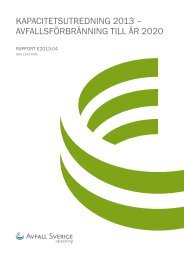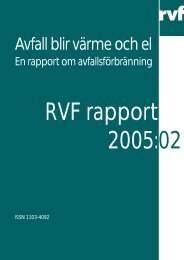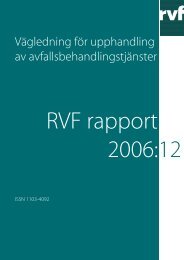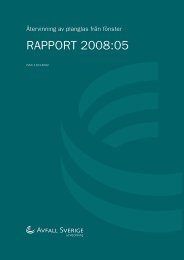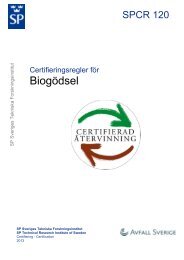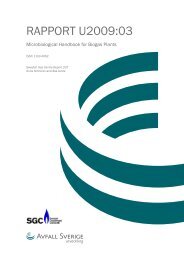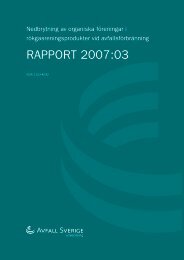You also want an ePaper? Increase the reach of your titles
YUMPU automatically turns print PDFs into web optimized ePapers that Google loves.
Summary<br />
In the past, zinc oxide has had no classification in the databases that exist for dangerous properties. In<br />
the classifications that have been made in accordance with the Ordinance of waste (<strong>Avfall</strong>sförordningen,<br />
SFS 2001:1063), it has been convenient as well as cautious to use zinc oxide as a reference substance<br />
in spite of the fact that the availability of zinc (i e the leachability) in ash is much lower than<br />
that for zinc oxide.<br />
However, from the end of 2005, zinc oxide has received a much stricter classification. <strong>Avfall</strong> <strong>Sverige</strong><br />
has therefore commissioned Tekedo AB to investigate the availability and to identify, if possible, what<br />
reference substance to select in order to achieve a more realistic but yet still cautious representation of<br />
the properties of zinc in ash.<br />
Information searches and literature compilations have been carried out in scientific data bases and<br />
papers, in books and on the Internet. The analyses have included availability in combination with<br />
properties over time. Comparison has been made with similar high and low temperature type of materials<br />
such as high temperature modified rock (metamorphic rock), lime and cement, and natural soil<br />
material, sediment, and cured lime and cement mortar, respectively. The compilation and analyses<br />
have included “traditional” investigation techniques such as leaching, thermodynamic calculations and<br />
x-ray crystallography as well as EXAFS (Extended X-ray Absorption Fine Structure).<br />
All the sources found have unanimously provided a single interpretation and view. Most likely, zinc<br />
appears as a minor element in phases where other elements are the major ones. Thus, the availability<br />
of zinc becomes that of the major elements that form the “mother” phase, i e the availability of zinc in<br />
ash becomes typically very low. In these phases, zinc occurs together with iron-II, magnesium and<br />
manganese-II which have similar ionic radii and chemical properties. These elements form mixed oxides<br />
with iron (e g spinels) as well as certain silicates with infinite sheet structures (micas). One such<br />
mixed oxide with iron is franklinite, which has an ideal composition (i e there are exact and simple<br />
ratios between atoms of different kinds). This mineral represents the availability of zinc in ash in a<br />
reasonable way and it also occurs in data bases for dangerous substances. On these grounds, franklinite<br />
has been selected as the proposed reference substance for zinc in ash.<br />
This selection is not warranted under all conditions, however. The ash should have a relatively “normal”<br />
chemical composition, and also tests should prove that the availability of zinc in aged ash is actually<br />
low.<br />
Moreover, the zinc that actually leashes out should be figured as zinc oxide, and thereby contribute in<br />
the summations of the dangerous properties in accordance with Appendix 3 of the Ordinance of waste.<br />
4 :





